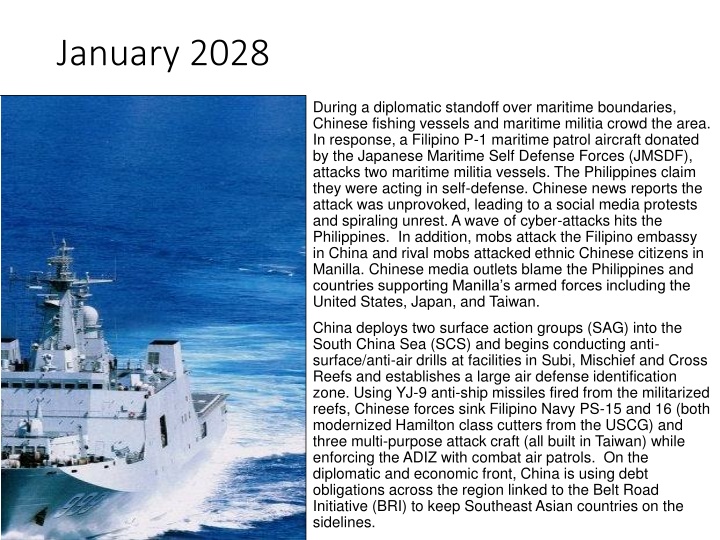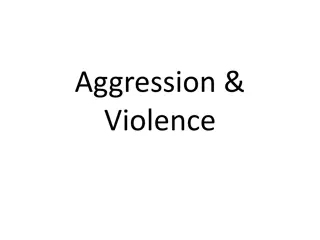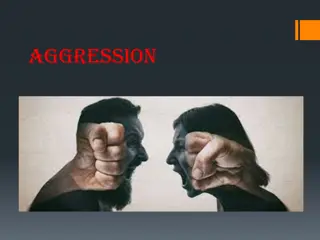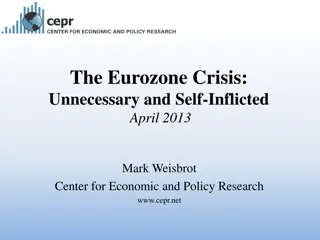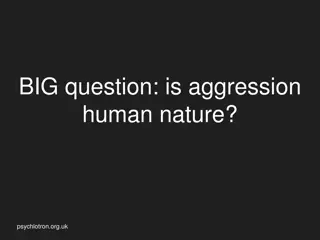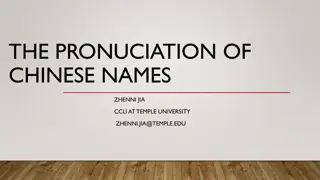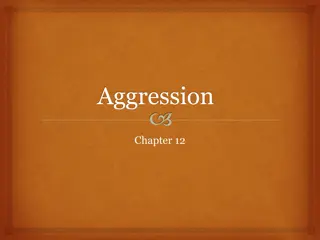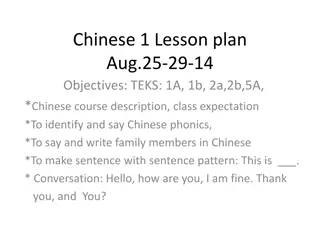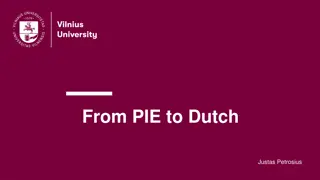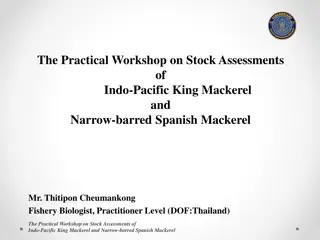Indo-Pacific Crisis: Managing Chinese Aggression in 2028
In January 2028, a maritime standoff between China and the Philippines escalates, leading to cyber-attacks, social unrest, and military clashes. By February, the Indo-Pacific Command activates JTF 77 to counter Chinese aggression in the region, focusing on limited military objectives. Amidst escalating tensions, global markets plunge, and the threat of a larger Pacific war looms, requiring careful crisis management and strategic planning to avoid nuclear escalation.
Download Presentation

Please find below an Image/Link to download the presentation.
The content on the website is provided AS IS for your information and personal use only. It may not be sold, licensed, or shared on other websites without obtaining consent from the author.If you encounter any issues during the download, it is possible that the publisher has removed the file from their server.
You are allowed to download the files provided on this website for personal or commercial use, subject to the condition that they are used lawfully. All files are the property of their respective owners.
The content on the website is provided AS IS for your information and personal use only. It may not be sold, licensed, or shared on other websites without obtaining consent from the author.
E N D
Presentation Transcript
January 2028 During a diplomatic standoff over maritime boundaries, Chinese fishing vessels and maritime militia crowd the area. In response, a Filipino P-1 maritime patrol aircraft donated by the Japanese Maritime Self Defense Forces (JMSDF), attacks two maritime militia vessels. The Philippines claim they were acting in self-defense. Chinese news reports the attack was unprovoked, leading to a social media protests and spiraling unrest. A wave of cyber-attacks hits the Philippines. In addition, mobs attack the Filipino embassy in China and rival mobs attacked ethnic Chinese citizens in Manilla. Chinese media outlets blame the Philippines and countries supporting Manilla s armed forces including the United States, Japan, and Taiwan. China deploys two surface action groups (SAG) into the South China Sea (SCS) and begins conducting anti- surface/anti-air drills at facilities in Subi, Mischief and Cross Reefs and establishes a large air defense identification zone. Using YJ-9 anti-ship missiles fired from the militarized reefs, Chinese forces sink Filipino Navy PS-15 and 16 (both modernized Hamilton class cutters from the USCG) and three multi-purpose attack craft (all built in Taiwan) while enforcing the ADIZ with combat air patrols. On the diplomatic and economic front, China is using debt obligations across the region linked to the Belt Road Initiative (BRI) to keep Southeast Asian countries on the sidelines.
February 2028 In response, the INDOPACOM stands up JTF 77, consisting of a Littoral Combat Group (LCG) already forward deployed in Palawan, an ESG, a PACAF ACE and Army Multi-Domain Task Force (MDTF). There are additional TSOC elements in Palawan. No additional forces are available given additional Chinese task forces operating near Taiwan and Japan and the threat of a larger Pacific war. In the early hours of February 28, 2025 power goes out at the main international airport in Palawan and a series of cyber attacks disrupt local communications. There are initial reports that a PLA Airborne TF seized the airfield. The ODAs report interdicting Chinese SOF forces surveying sites along Nagtabon Beach Filipino. Social media reports Chinese military vehicles vicinity Urugan Bay. China has not declared war and reports "sympathetic elements" may be conducting a NEO to save Chinese tourists. There is no change to Chinese nuclear posture and their road mobile missiles and subs remain at a low alert level. Intelligence reports indicate this posture is signaling a desire to avoid nuclear escalation. Chinese forces have not attacked space-based assets and there is no change in the posture of facilities associated with counter-space activity. At the same time, there are indications and warnings of strategic mobilization activities indicative of a possible large-scale attack against Taiwan. Global stock markets plunge and the price of gold skyrockets.
Crisis Management During an NSC meeting, POTUS stresses that he/she wants viable military options for countering Chinese aggression that demonstrate US capability and resolve, reassures treaty partners in the region and avoids nuclear escalation. Following the meeting SECDEF contacts INDOPACOM Commander. In consultation with the Joint Chiefs, they determine that countering the Chinese through conventional operations in and around Palawan is the only viable military option to manage escalation. They stress that the operation must involve limited military objectives that do not signal a threat against mainland China and avoids striking dual use nuclear facilities. INDOPACOM Commander works with the J55 and adapts portions of a key contingency plan. The plan calls for using flexible response options with an emphasis on diplomacy to build the counter-China coalition and economic pressure while conducting a limited military operation to demonstrate capability and resolve and signal the risk of further conventional military escalation. With multiple carrier strike groups and larger portions of the USAF tied up with separate plans to defend Japan and Taiwan, the task falls on JTF 77. INDOPACOM orders JTF 77 to support Filipino forces clearing Palawan of Chinese military forces. The purpose is to ensure the Chinese forces don t use Palawan as a lodgment to threaten the Sulu Sea and other islands in the Philippines, that the conflict is contained and China has crisis offramp options while US treaty commitments are upheld. INDOPACOM orders JTF 77 to: 1. Seize the Palawan International Airfield in order to establish a secure lodgment for follow-on forces 2. Establish sea control at least 100 km west of Palawan in order to secure SLOCs in the Sulu Sea
Flight Time to Guam 3 hrs Active Airbases 3 4 PLAN SAG 2 1 Seized Airfield 1 LCG 2 4 SSN Suspected Sub Locations ESG Hawaii (ACE package) Australia (Darwin Base) Japan (Multiple Bases) 1 = ODAs; 2 = EAB (HMH, HIMARs, LAAD); 3 = EAB (VMU, MWSS, FILMAR); (MDTF); 4 = RQ-180s Treatment B = Less strike and more enablers & bases (decoys included); Mosaic
PLA Assessment PLAN (SCS) 2-4 Frigates (Type 54) 2-4 Destroyers (Type 52, 54) 1 CG (Type 55) 6+ fast attack (Type 21) 5+ SAM BN (HQ-9) SCS islands 2+ SSM BN (YJ-62) - SCS islands 3+ Radar sites (air, surface) SCS islands 4+ attack subs (Kilo, Yuan) 1-2 supply (Type 93) Type 55 PLAAF (SCS, Woody Island airbases) 20+ TACAIR (J-10, J-11, JH-7) 10+ H-6M OTH Radar (Woody) 2+ Soar Dragon DF-26 HQ-9 PLA (Palawan) Airborne Company Team (1 x Armor PLT ZTQ, 2 x INF PLTs, 1 x artillery platoon, AAA section) J-10 H-6M Rocket Forces (Mainland) 4 DF-26 BNs SSF Use of OECM from SCS Islands Limited use of cyber to support targeting PLA ABN Soar Dragon MLECOA: (PH 1) SAG will conduct sea control vic SCS IOT to secure the area and support an amphibious assault on Palawan. After PLA forces deploy 2x Marine Battalions to reinforce PLA airborne units holding Palawan airport, (PH2) the SAG and supporting PLAAF forces will transition to conduct sea control in the Sulu Sea IOT deny CJTF forces access to Palawan. Denying US forces access is the main effort. PLA/CCP leaders view limiting US forces as the best path to producing a fait accompli.
Phase 1 Mission: Turn Concept ECOG/CV: FCOG/CV: P/M/E: HVT: HPT: Decisions: Risks/Opportunities: OP Box Forces WEAPONS (tight, free) EMCON (emit, no emit) COORDINATING INSTRUCTIONS 1.Surface 1a 1b 2. Subsurface 2a 2b 3. Strike 3a 3b 4. Air 4a 4b 5. Info 5a 5b
Phase 2 Mission: Turn Concept ECOG/CV: FCOG/CV: P/M/E: HVT: HPT: Decisions: Risks/Opportunities: OP Box Forces WEAPONS (tight, free) EMCON (emit, no emit) COORDINATING INSTRUCTIONS 1.Surface 1a 1b 2. Subsurface 2a 2b 3. Strike 3a 3b 4. Air 4a 4b 5. Info 5a 5b
Phase 1 Mission: write the phase 1 mission statement Turn Concept ECOG/CV: identify the enemy COG and CV (what you can target) FCOG/CV: identify your COG and CV (what you should protect) Example = ECOG = long-range fires (ASBM, LACM) CV = ability to target (so attack ISR platforms). P/M/E: State the purpose, method, and end state. For example P: set the conditions for an amphibious assault on the airfield. M: establish air superiority and clear sub threat while destroying PLA ISR capabilities. E: At the conclusion of phase 1 CJTC is postured to seize the airfield and no PLAN forces are within 50 KM of the Sulu Sea. Deny PLA use of surface-to-surface and air-to-surface capabilities vic SCS. HVT: state the HVTs (for example Type 71s, HALE ISR, ASBM\ALCM) HPT: state the HPTs (for example Type 71s, HALE ISR) 3a, 3B 4a 1b 1b 1a 4b 5b Decisions: state key decisions (for example, when to transition) Risks/Opportunities: state major risks (mission, force) and opportunities Use the note for additional text OP Box Forces WEAPONS (tight, free) EMCON (emit, no emit) COORDINATING INSTRUCTIONS 1.Surface 1a. ESG, LCG free no emit Consolidate surface combatants until est. localized air superiority and neutralize enemy sub threat; 1 x DDG emit; HIMARS attack HPT 1b. HIMARS. MDTF, RQ-180 free no emit 2. Subsurface 2a. MH-60R, P-8s free emit Establish air superiority before conducting ASW. 2b.SSN free emit Conduct ASW patrol until air superiority established 3. Strike 3a. DDG (TLAM) tight no emit Attack radar/SAM installations vic SCS 3b. B-1, 6 x F-22 (escort) free no emit SPT base attack vic SCS, BPT to attack PLAN. 4. Air 4a. TACAIR free emit Establish air local superiority 4b. Refuelers, E-3 free emit Establish C2 and refueling 5. Info 5a. Decoys free emit Deceive PLA sensors/shooters 5b. OECOM free emit OECM at EABs disrupt PLA sensors/C2
Phase 2 Mission: Turn Concept ECOG/CV: FCOG/CV: P/M/E: HVT: HPT: Decisions: Risks/Opportunities: OP Box Forces WEAPONS (tight, free) EMCON (emit, no emit) COORDINATING INSTRUCTIONS 1.Surface 1a. B-1, 4 x F-35 free no emit B-1 support sea control; F-35 escort and ISR 1b. ESG, LCG, SSN free No emit Amphibious assault seized the airfield (3); B-1s support sea control 2. Subsurface 2a. MH-60, P-8 free Emit Conduct ASW 3. Strike 3a. MDTF tight No emit Support Amph Assault 4. Air 4a. TACAIR free emit Establish air superiority 4b. Refuelers, E-3 free Emit Establish C2 and refueling 5. Info 5a. Decoys Free Emit Deceive PLA sensors/shooters 5b. OECM Disrupt C2 and sensors for PLA
